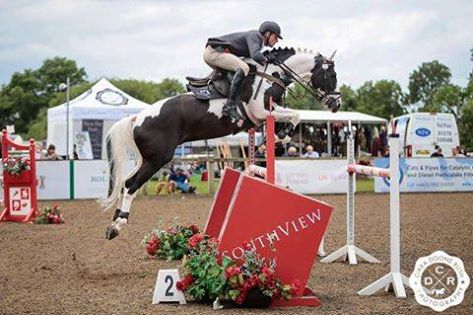Equestrian Safety
There is a great deal more to horse safety than just wearing a hard hat though that is certainly basic. After 70 years of riding, 35 years of leading and organizing riding trips and working as an expert witness in riding accident cases, I have formed some strong ideas about the leading causes of riding accidents. They often aren’t what people think. In my experience it is rare that speed alone is the cause of an accident. I have found that the following avoidable risks account for the vast majority of serious accidents.Not wearing a hard hat
Failure to match horse and rider
Going too fast on dangerous terrain
Failure to check cinches a first time and a second time after a few minutes of riding
Attaching lead ropes or reins firmly at inappropriate times
A hat or coat falling from a horse in front and spooking the ones behind
A kick from a horse
On foot in the corral
Riding when overweight and out of shape
Lagging behind and catching up by speeding forward
Prematurely “bailing out” to get off a runaway
Unqualified ride leaders
Having too many riders for the number of guides
Improper mounting and dismounting
Tying a horse with too much slack
Riding with loose horses
Riding around wildlife can add hazards to horse safety
Hard hats are now universally accepted as necessary for equestrian safety in jumping.
Wearing a hard hat - If you are enjoying your life, it makes no sense to ride without a hard hat. They are not that onerous to wear and can often prevent or attenuate head injuries in falls. A head injury is usually far worse than a broken bone and those who have them often do not completely recover. About ten years ago a lovely young woman signed a special release not to wear a hard hat before riding with me. An hour later she fell, hitting her head on a rock and went into seizures. She will never be the same; nor will I ever forgive myself for allowing her to ride without protection. I don’t intend to make that mistake again. Since making hard hats mandatory at our ranch ten years ago we have had one or two hats a year damaged when people took falls and I am convinced that we have avoided several concussions as a result. Hard hats are basic to horse safety: don't let the Marlboro mystique lead you astray.
Matching horse and rider - I think proper matching of horse and rider is the most important factor in avoiding accidents. A spirited, athletic horse can scare the daylights out of a novice and a tired old plug can bore an experienced rider. An actual evaluation by a qualified instructor of a person’s riding skills is the best way to judge since many people do not really know how well they ride according to the standards of the place where they are riding. If it is a matter of a riding tour, it is vital that riders should be experienced and fit enough to do the trip as it was intended to be done and the difficulty should be clearly spelled out. Riders with insufficient skills can ruin the ride for riders who are qualified and be a danger to themselves and the other riders.
Be careful not to make a jump like this where you will land in slippery mud. This place seems to be safe.
Too fast on dangerous terrain - I must have taken over a hundred falls in my time and rarely been hurt, but the accidents I think most likely to cause injury are when the horse falls, especially if you are under him. Three of the four accidents which caused me trouble for more than a few days were when the horse went down. Twice it was slippery mud and once it was an aardvark hole in Kenya when we galloped too fast through grass tall enough to disguise holes. Many animals like badgers, prairie dogs, ground hogs, wart hogs, aardvarks, wombats and many others make holes which it can be very difficult for horse or rider to see at a gallop. Down barb wire can also be a problem and so can an unexpected patch of slippery mud. We cannot always be galloping on a race track and probably most people want to take the risk of falling at times, but it should be done with full awareness of the danger and the worst places should be approached with caution.
Failure to check cinches - Some horses seem to blow up their chests when a cinch is first tightened and of course one should be certain they are tight before the rider mounts. Perhaps, as some maintain, the blowing up is an illusion, but it certainly pays to check them again as soon as the rider is mounted and still another time after five minutes or so of riding. Whatever the reason, they will often loosen. There have been many accidents when someone failed to check the cinch on the first mounting or failed to check again after a few minutes of riding. I think it is worth checking again after a few hours of riding, particularly if the horse has round withers. When you have done up 10,000 cinches properly there is a danger of inattention the 10,001st time. Many are the old cowboys who have forgotten to do their own cinches properly once or twice. The cinch is also the most important part of the tack to check carefully for any possible weakness. Making a cinch too tight can be a horse safety issue as well because if a horse gets too uncomfortable it may buck or roll.
Tight Dalley and a Loose Latigo by Charles M. Russell
Attaching lead ropes and reins - Naturally at times it is necessary to tie a horse to a fixed object like a tree, a solid fence, a picket line or a hitching post. A horse should never be firmly tied when a rider is on its back as they tend to feel trapped and will often buck or pull back. While a rider is leading a horse the lead rope should never be firmly attached to the saddle or the body of the person. The horse can pull back hard enough to make the lead horse fall, buck or to drag the rider. People have tried to their sorrow to lead horses by tying them to a four wheeler because horses can easily tip them over. When leading a pack string I think it is usually best to have the pack horses behind the lead horse attached with a thin rope which will break if a horse pulls on it hard. This means that one horse is not so likely to get the others into trouble and it is more likely to settle down quickly if no longer attached. The breakaway rope also reduces the chance of accident in case a pack string is spooked by a bear, a falling tree or whatever. A string of firmly attached pack horses running abreast in a panic can mow down the riders in their path. I never like to tie a horse to a dead tree since they may be rotten and if a horse pulls back hard, it can make the tree fall. I have seen a horse drag a dead tree 15 ft. high around, causing pandemonium with the other horses.
Falling object from horse in front - I have seen many falls as a result of a horse making a sudden turn or stop when the rider in front lost a hat or a raincoat or other object tied on the saddle carelessly. I rate this high as a cause of easily avoidable accidents and an important threat to horse safety.
Kicking - Any horse can kick and one should always be aware of this. Many have broken legs as a result. Do not approach the horse in front of you too closely whether it is a known kicker or not. Take extra care with horses which do kick.
On foot in the corral - Some riding establishments keep guests away from the corrals or saddling areas because many accidents can occur there. A tied horse can spook and pull back, sometimes breaking a lead rope or hitching pole which can cause pandemonium. Horses can be more nervous around people on the ground if they do not know them. When you move behind a horse, you are safer either very close or out of range.
Overweight and out of shape - Riding is an athletic sport which demands good muscles and a trim body for the best results. Those who feel that it should be like sitting on a motor cycle should stick to motor cycles. A rider who is overweight cannot perform as well because he puts more stress on the same muscles if he is 20 lbs. overweight. If he falls, an injury is more likely because the greater weight puts more stress on the same bones. It goes without saying that extra lbs. make a huge difference to the horse. Look how jockeys struggle over a pound and what a little extra weight does to the speed of a race horse. Overweight people do not like to recognize the importance of weight and fitness in horse safety.
Lagging behind - I have seen several serious accidents occur because someone in the riding group felt the pace to be too slow and held a horse back so they could gallop up to join the others. This often makes the horse held back frantic so that it gallops up at speed and crashes into the rest of the group, getting the other horses very excited and out of control. It can also be dangerous to have an inexperienced rider fall behind a group unintentionally because she does not know how to make the horse keep up close to the others. Even a quiet, lazy horse which may have been grazing along the trail can suddenly decide to move forward quickly when it gets the urge to join the other horses and inexperienced riders may not be able to handle this safely.
Beaches usually provide excellent footing for fast gallops, but many horses get used to running there and can be hard to slow down. Ride it out until they tire; don't panic.
“Bailing out” - I have known people to throw themselves off a runaway horse because they were terrified and wanted the terror to end. I believe this is usually a big mistake. Horses are not often suicidal and when they tire they will slow down. Usually one can ride it out. I did correctly bail out once when a rock gave way under my horse’s leg on a narrow trail and he went over a cliff, but those situations are rare. Another time when I was leading a ride on a very spirited horse the metal bit broke near the middle and I was left with no control as we were starting a canter. The horse leapt forward like a rocket when he felt the pressure on his mouth give way and I was badly scared. The thought of bailing out did cross my mind, but fortunately I rode it out and a mile or so later he came to a stop of his own accord. The riders behind me thought I had gone crazy.
Unqualified ride leaders - Ride leaders need to be not only good riders themselves, but they need to pay careful attention to the others in the group. Great Britain and France require commercial ride leaders to take courses and pass exams before they can be licensed, but nothing of the kind exists in the United States which means that totally unqualified people often lead rides and ignore basic horse safety rules.
Too many riders for the number of guides - There is a limit to how many riders each guide can keep track of. Of course the skill of the riders is an important factor and if the group is experienced, there is less need for supervision. Generally I believe that a ratio of six horses to a guide is about the safe limit. I say horses because a guide leading pack horses has to give them some of his attention and if there are four or five of them, it means that he will be 20 yards or more from the first guest if they are going single file. The guide leading pack horses is also hampered in going to the assistance of a rider if need be because leaving the pack horses unrestrained can be a hazard in itself since they could turn and run back through the riders. A single guide leading five or six riders always poses a problem because one cannot constantly be looking backward, particularly at a gallop. I believe it is safer to have two guides with one leading and one behind, but it usually does not make economic sense to have more than one guide for small groups. Having too large a group can also become a safety hazard, particularly if the group is moving at all gaits. If a group spreads out on an open plain for a canter and the horses and riders are keen, some have a tendency to edge ahead. Then the other horses will want to catch up and the next minute they can all be excited and going flat out. They may not be easy to stop before they come to a place with dangerous holes, down barbed wire or quick sand.
Mounting and dismounting - Like take-offs and landings, mounting and dismounting are potentially dangerous times. They require the rider to put all her weight on the left side of the horse which throws the animal off balance and can cause it to react. While the rider has one foot out of the stirrup she is vulnerable to any sudden movement of the horse and has poor control of the reins. It is also a time when a sudden forward movement of the horse can cause the rider’s left leg to be caught in the stirrup and then be dragged so that the left foot should come out of the stirrup before the right leg gets close to the ground. Obviously long legged, athletic riders can get away with this more easily and safely. Someone should be holding a horse while a rider mounts if there is any question about mounting safety and sometimes also when dismounting. A secure mounting block makes getting up much easier and safer for most guests. Another risk in mounting is that with all the weight in one stirrup it tends to pull the saddle over to that side. If riders can get on with one quick, fluid motion, there is less chance of the saddle slipping, but use of a mounting block reduces the pull to the left side because it is far easier for the rider to get her weight properly balanced quickly rather than struggling up from the ground. At times it may also be helpful for someone to hold the right stirrup down while the rider mounts to compensate for the weight on the left side. Of course mounting blocks are not always available, but usually a substitute can be found or someone can give the rider a leg up. Before mounting the rider should always be holding the reins in her hand.
Endurance riders in Northern California have become more conscious of equestrian safety issues.
Tying a horse with too much slack - If there is too much slack in a lead rope when a horse is tied it is easy for the horse to get a leg over the rope and if they pull back they can become entangled and hurt themselves seriously. When riders stop for a picnic, it is a temptation to leave the lead rope long enough to allow the horse to graze a bit. I have seen many accidents caused by this practice and am convinced that the risk is seldom worth the small amount of grass they get that way. Many horses have gotten serious rope burns in this manner which can put them out of action for weeks. These days when horses are put out to graze in a place where they must be restrained, an electric fence is normally used, but if they must be picketed, I believe it is safer to tie them by a leg just above the hoof rather than by a lead rope attached to a halter as the horse is less likely to become entangled.
Riding with loose horses - Loose horses in a riding group can cause accidents by crowding the ridden horses, making them veer to the side or stop suddenly and by kicking. They can also excite the ridden horses by running ahead and making it difficult for riders to hold their mounts at a controlled canter. On the other hand, sometimes riding with loose horses can be difficult to avoid. When we are traveling 200 miles or so in a week across the African bush and have no easy resupply of mounts, we need to take several extra horses in case some go lame or tire. One can hardly ask guests to lead them and if there are four or five of them, they are extremely hard to handle at a gallop unless they are very well trained to lead. At home I have galloped with up to three tailed horses without mishap in open country, but many horses do not respond well to tailing. I remember well one day in Africa when we had 35 miles to cover. About twelve of us were galloping along on an open plain with several herds of zebra and wildebeest not far away. There were five loose horses and as a herd of zebra galloped across our path in a racing challenge, which is tremendously exciting to horses, the five of them followed after the zebra at top speed, cutting across our path too close. One of them crashed into our lead horse making it fall. The rider, a black groom, dove head first into a termite mound. Two other riders fell in the pandemonium. Sometimes it is difficult to avoid these situations, but one should be aware of the dangers. An exception is in Iceland where it is common practice to ride with a group of loose horses for frequent changes. These small horses are extraordinarily good tempered and accustomed to this routine so that there seems little safety risk. There are many other parallels in history like the fabulous cavalry of Genghis Khan, but they aren’t appropriate in most situations today.
Wildlife can be a risk to horse safety, but the rewards are great.
Riding around wildlife can add hazards to safety - Riders need to be particularly alert and keep their feet firmly in both stirrups where close encounters are likely. We shouldn't forget that horses are prey animals and the ability for instant, unhesitating flight kept their ancestors alive. In thick cover the lead horse is most likely to spook most violently and unexpectedly, giving the riders behind a split second of warning. A horse can leap to the side or do a fast 180 degree turn, crashing past the horses behind. A deer, a bear, an elk or especially a moose suddenly seen or smelled close by can cause a stampede. Making a little noise in places where there are likely to be encounters can usually avoid difficulty as the wildlife will usually depart before you are close. Suddenly flushing birds like grouse or pheasant can also spook horses badly and they can shy at domestic cows they see unexpectedly. They have a special terror of llamas. In Africa wart hogs can burst from their holes at the last moment as riders approach. Horses can quite easily outdistance sometimes aggressive animals like Cape buffalo and elephant. Lion, on the other hand, are much faster than a horse, but can only run at top speed for short distances, so, if you have a little head start, you should be alright. Of course it is embarrassing to fall off when being chased in those circumstances.
Horses have a terrific sense of smell and a whiff they don't like can cause a mighty spook. Once I was riding on wide open sagebrush plains when a herd of pronghorn antelope decided to race cross in front of us several hundred yards away. The horses watched them intently, especially my spirited Arabian and when they had disappeared, we proceeded on our way. I relaxed too much because, when we crossed the path of the antelope my horse got a whiff of them and made an abrupt 180 degree turn. Another thing to watch out for is that horses can spook at a place where something they didn't like happened there in the past. One day I was riding a very spirited Arabian near a patch of willows. Being higher than the horse, I spotted a cow ahead before he did and got ready for trouble so that when he did a 180, I was ready. Going by the same place the next week I looked carefully ahead: no cows around, but when we came to the exact same place he did a 180 anyhow and I was dumped.
As in any sport, no matter what precautions are taken, accidents can occur. It is therefore important to have plans in place to get quick and effective help in case of need. When riding in remote places a cell phone, satellite phone or radio can save critical time and if someone in the group has first aid knowledge it can make a great difference. In my experience horseback riding need not be a dangerous activity when compared to a sport like down-hill skiing. This is especially true if basic horse safety procedures are carefully considered.
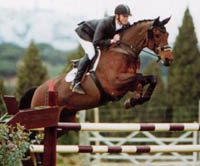
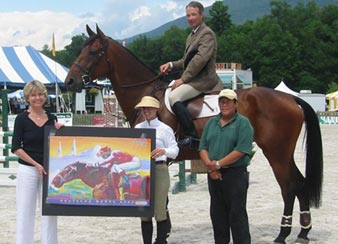
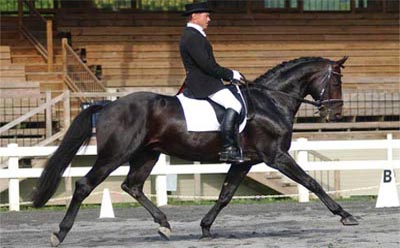
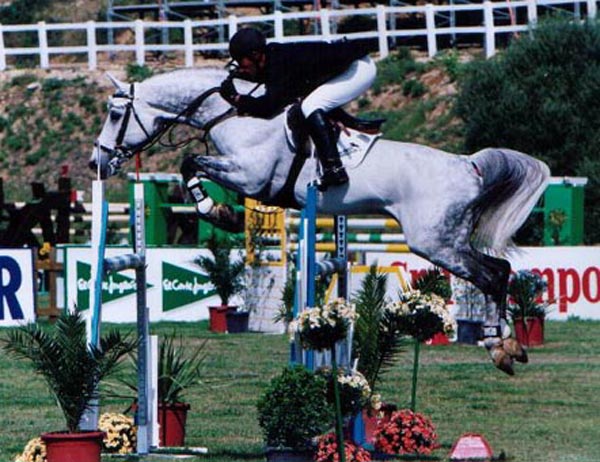
Ekaterina Rybolovleva | Horse For Sale | Pippa Funnell | Advanced Security Systems | Sports Horses
French Patio Door | William Plunkett | Darco



